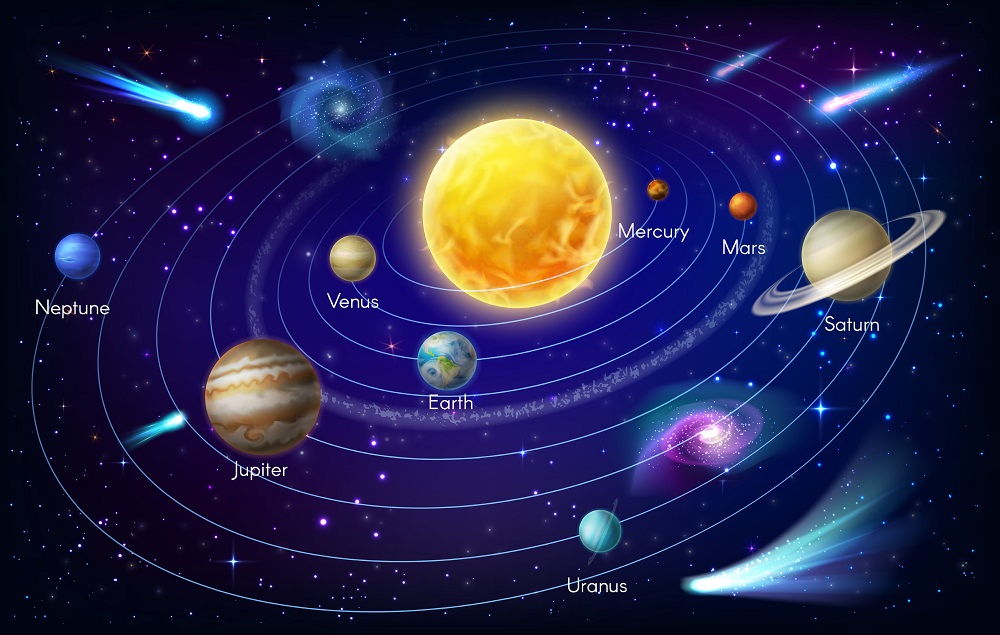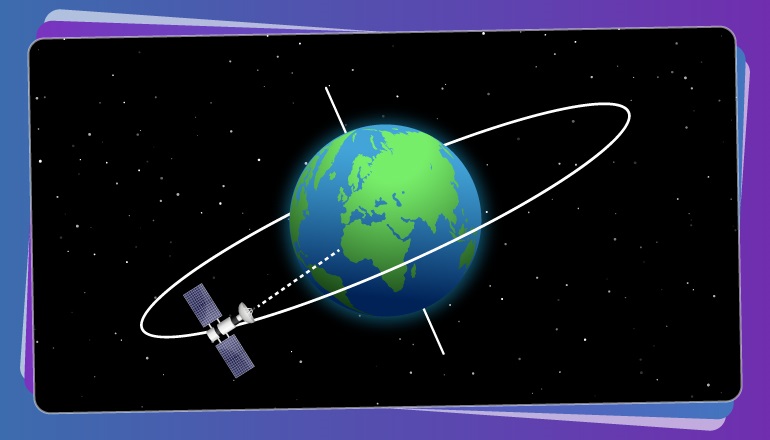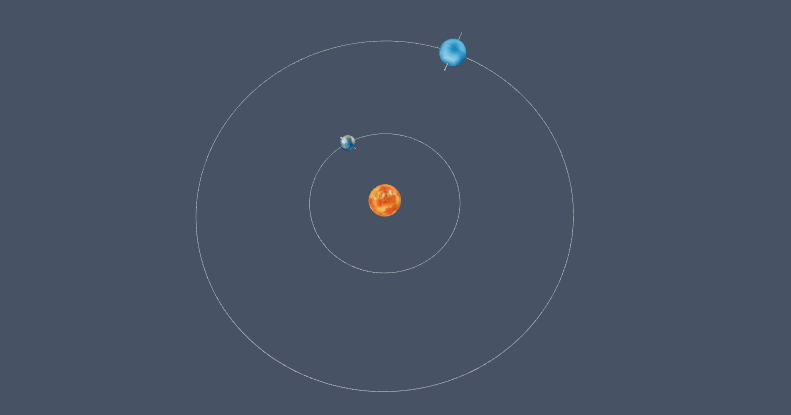
Solar System 3D Model - Learn Solar System in Metaverse

Our solar system is located in an outer spiral arm of the Milky Way galaxy. The solar system consists of the Sun and everything that orbits or travels around, the Sun.
The major players in our solar system include the eight planets and their moons, while the minor players include comets, asteroids, and meteoroids. All of these celestial bodies interact with each other in some way.
The eight planets of our solar system are Mercury, Venus, Earth, Mars, Jupiter, Saturn, Uranus, and Neptune.
All eight planets have their own unique features. Some are small and rocky, while others are large and gassy. Some are so hot that metals would melt on the surface, while others are cold.
There are many dwarf planets like Pluto, dozens of moons, asteroids, comets, and meteoroids of all kinds in our solar system. Pluto is located in the Kuiper Belt, which is past the outermost planet, Neptune.
Let’s take you on a tour of the solar system. Watching a solar system 3d model will be even more fun.
Solar System Model
Sun
The Sun is a star and is the largest body in our solar system. It is located at the center of the solar system. The Sun is made up of mostly hydrogen and helium gases.
It constantly changes the hydrogen in its core into helium, which gives off huge amounts of radiation. This radiation is emitted from the sun in the form of light and heat, and living things on Earth depend on it.
Mercury
Mercury is the smallest planet in our solar system and is slightly bigger than Earth's moon. Mercury is closest to the sun out of all the planets, but it's not actually the hottest planet. That honor goes to Venus!!
Mercury and Venus, Earth, and Mars are rocky planets. It has no moon, no atmosphere, and its solid surface is filled with craters. It completes one revolution around the sun in just 88 Earth days. So a year is quite small on Mercury.
Venus
Even though Venus isn't the closest planet to the Sun, it's the hottest planet. It has a thick atmosphere full of the greenhouse gas carbon dioxide and clouds made of sulphuric acid.
The gas traps heat and keeps Venus hot. In fact, it's so hot on Venus, metals like lead would be puddles of melted liquid. Like Earth, Venus too shows activity and has mountains and volcanoes. It is also similar in size to Earth.
A unique feature is that Venus spins in the opposite direction of Earth and most other planets. It takes 243 Earth days to complete one rotation and 225 Earth days to go all the way around the Sun.
That means a day on Venus is longer than a year on Venus!
Earth
The Earth is our home. It has a solid surface and is a rocky planet. Water covers 70% of the Earth’s surface. It also has mountains, volcanoes, and canyons. The earth’s atmosphere is made up of nitrogen and oxygen, which favour life.
As the only known planet in our solar system with these conditions, Earth is a precious place that we must work to protect.
Mars
Mars is a cold, arid world. It is only half the size of Earth. Mars gets its red hue from the rusty iron in its ground. Like Earth, Mars experiences seasons has polar ice caps and volcanoes and has various types of weather.
However, Mars has a fragile atmosphere made up of carbon dioxide, nitrogen, and argon.
There is evidence of ancient floods on Mars, but now water mostly exists in icy dirt and thin clouds. On some Martian hillsides, there is evidence of liquid salty water in the ground.
Mars may have supported life in the past. Scientists keep exploring whether Mars could support life now or in the future.
Jupiter
Jupiter is the largest planet in our solar system. Because it is so large, Jupiter's gravity pulls in a lot of gas and dust, which makes it similar to a star. Jupiter, however, never became massive enough to start burning.
Jupiter's atmosphere is mostly hydrogen and helium. Jupiter is called a gas giant because it has no solid surface. However, it may have a solid inner core about the size of Earth.
Jupiter also has rings, but they are too faint to see very well from Earth. A day on Jupiter lasts only 10 hours, while a year equals 11.8 Earth years.
Saturn
Other planets have rings, but Saturn's are the most beautiful. The rings around Saturn are made of tiny ringlets that are made of chunks of ice and rock. Just like Jupiter, Saturn is mostly a ball of hydrogen and helium.
Saturn has seven lovely main rings with spaces in between them. A day on Saturn lasts 10.7 hours; a year is equivalent to 29 Earth years. Saturn also has an unbelievable 63 confirmed moons.
Uranus
Uranus has a small rocky center, and its atmosphere consists of hydrogen, helium, and methane. The methane gives Uranus its blue color. Uranus also has faint rings. The inner rings are narrow and dark.
The outer rings are brightly colored and easier to see. Unlike any other planet, Uranus rotates on its side. One day on Uranus is over 17 hours 14 minutes, while a year equals 84 Earth years.
Neptune
Neptune is 30 times farther off from the sun than the Earth. It is a dark, cold, and windy planet. Neptune, too has a solid center, and its atmosphere is made up of hydrogen, helium, and methane.
The methane gives Neptune the same blue color as Uranus. Neptune has six rings, but they're tough to see.
A day on Neptune lasts only 16 hours, while Neptune’s year equals 165 earth years.
Explore the Solar System in 3D with Edverse
Edverse can take students on a mesmerising and immersive journey of the solar system. With high end 3D visualization tools students can take a tour of the 3D solar system model within the metaverse and explore the entire cosmos.
Follow the orbit of the sun and the path of the celestial bodies and go back into the past or the future as you wish.
So don your space helmet and start exploring!
_64675.jpg)


Frequently Asked Questions
Which celestial bodies does our Solar System include?
To date, our Solar System contains 1 star, 8 planets (Mercury, Venus, Earth, Mars, Jupiter, Saturn, Uranus, and Neptune), 5 dwarf planets (Pluto, Ceres, Haumea, Makemake, and Eris), 181 moons, 566,000 asteroids, and 3,100 comets
How does Edverse demonstrate 3D Solar System Model?
Edverse is a unique metaverse development company creating innovative educational content for k-12 and higher education. With the help of advanced technologies like metaverse, VR and 3D rendering, Edverse creates an immersive and interactive learning space. Students can actually space trave from their classrooms!